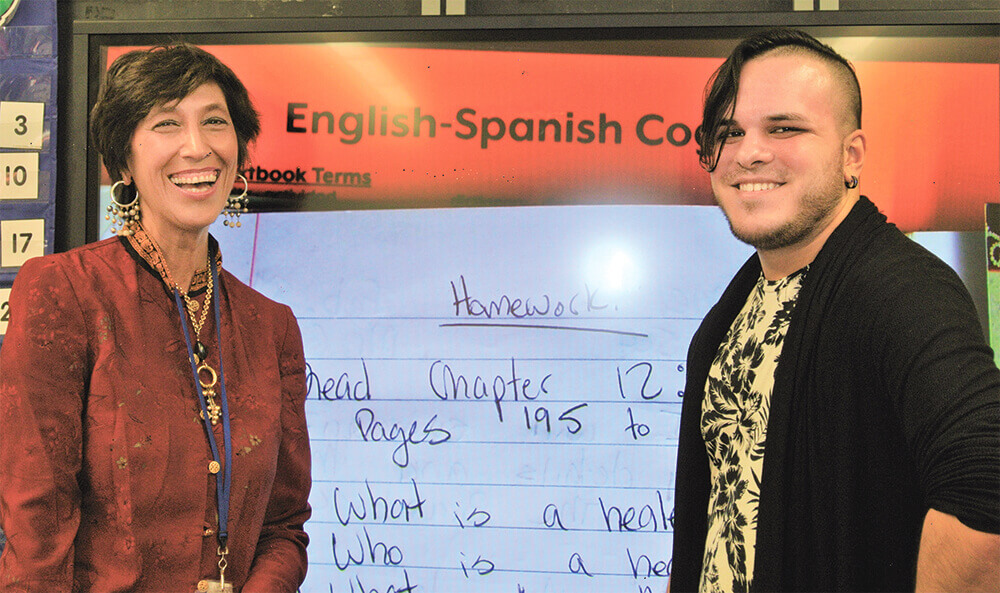A Clear Translation
How a Touro professor uses real-life scenarios to teach students how to bridge cultural gaps

Dr. Lucia Buttaro, Chair, Teaching English as a Second Language (TESOL)/Bilingual Advanced Certificate Programs at Touro's Graduate School of Education (GSE), works with 4th grade teacher Ana Lynn Demorizi and 5th Grade teacher, Michael Garcia at PS 192 The Jacob H. Schiff School, where 31 percent of the pupils are limited in English proficiency. The school teaches all of its classes bilingually with the goal of developing students who are 100 percent bilingual, biliterate and bicultural. Dr. Buttaro says, “The work that I do in the schools with teachers, I take to my students at Touro and blend these real-life situations in with the issues we are studying in the classroom. My Touro students are learning about real life scenarios and utilizing real samples of student work.”
BILINGUAL, BILITERATE, BICULTURAL
Xavier, a fifth grader, who recently arrived in the U.S. from South America, wanted to try out for the soccer team. His teacher, who always made sure to know about her students in and out of her classroom, wished him well as he headed off to practice saying, “Break a leg, Xavier.”
Immediately, Xavier grew very upset. Rather than hearing his teacher’s words as supportive, Xavier translated the phrase literally and believed his teacher wanted him to have an accident so he couldn’t play soccer. In the days that followed, the boy grew disruptive and withdrawn.
When Dr. Buttaro arrived at the school, as part of her work providing ongoing faculty development in bilingual education, she learned of Xavier’s suddenly changed classroom attitude. “As I talked with him and his teacher, I suspected a cultural miscommunication and began asking questions,” recalls Professor Buttaro. Ultimately, it came down to three words: “break a leg.” Once Xavier understood that it meant good luck, harmony was restored.
“There are a whole set of idiomatic phrases that are very confusing to English learners,” explains Professor Buttaro. “’Pig-out,’ ‘wolf down,’ ‘cost an arm and a leg,’ ‘pay through the nose,’ are just a few. As native speakers we know what they mean. But for the English learner, it’s very confusing.”
With New York’s schools some of the most culturally and linguistically diverse in the country, it would be impossible for teachers to speak every language that walks into a classroom. “In Manhattan alone 188 languages are spoken in the schools,” explains Professor Buttaro. “That incudes languages such as Swahili and Urdu. In one Queens, New York school, 36 languages are spoken in the same school building.”
The goal of Touro’s GSE certificate program for TESOL is to provide NYS-certified teachers with the tools to provide responsive, comprehensive education to students, such as Xavier, learning English as a new language. The Touro program provides a combination of classroom work focusing on theory and instruction strategies for multicultural education and second language acquisition. “One of the ways that we do this,” explains Dr. Buttaro, “is by taking real-life scenarios such as Xavier’s and bringing them back to the Touro classroom for discussion.”
Touro students learn techniques to encourage both auditory and visual learning. “We show our graduate students ways to provide visual and auditory cues on the walls in dual languages using pictures as well as words. For instance, elephant sounds like it has an “f ” in it but it’s really “ph”. Laugh sounds like an “f ” but it’s a “gh.” Dough has a “gh” but it’s silent. It can be very confusing for a student trying to make connections and looking for ways to follow rules because there are so many exceptions. We call it ‘language stress.’”
Part of Professor Buttaro’s work involves visiting schools in East Harlem, the South Bronx and Far Rockaway, many of them high-need, low-income with populations that are considered “at risk.” While there, she works with the faculty on curriculum development and assessment. “I bring back samples of what I find in these schools and present it to my students. I say, this is what I found, how would you go about solving this problem?”

